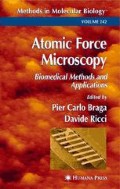Abstract
The cell nucleus is an organelle where molecules involved in gene expression are highly compartmentalized (1) in very dynamic (2) territories. This current notion of functional organization has been possible because of many studies of this organelle that included its cell and molecular organization, and where microscopy played an important role. Light and electron microscopy in conjunction with molecular approaches, such as the construction of both antibodies and nucleic acid probes, as well as molecular construction of genes with green fluorescent protein and fluorescence recovery after photobleaching technology, in addition to high-resolution in situ hybridization and immunocy-tochemistry now offer a more complete knowledge.
Access this chapter
Tax calculation will be finalised at checkout
Purchases are for personal use only
References
Spector, D. L. (1993) Macromolecular domains within the cell nucleus. Annu. Rev. Cell Biol. 9, 265–315.
Misteli, T. (2001) Protein dynamics: implications for nuclear architecture and gene expression. Science 291, 843–847.
Fakan, S. (1994) Perichromatin fibrils are in situ forms of nascent transcripts. Trends Cell Biol. 4, 86–90.
Vázquez-Nin, G. H. and Echeverría, O. M. (1996) The polytene nucleus in morphological, cytochemical, and functional studies of messenger RNA transcription, processing and transportation. Eur. J. Histochem. 40, 7–16.
Lamond, A. I. and Earnshaw, W. C. (1998) Structure and function in the nucleus. Science 280, 547–553.
Matera, A. G. (1999) Nuclear bodies: Multifaceted subdomains of the interchromatin space. Trends Cell Biol. 9, 302–309.
Lewis, J. D. and Tollervey, D. (2000) Like attracts like: Getting RNA processing together in the nucleus. Science 288, 1385–1389.
Gall, J. G. (2000) Cajal bodies: The first 100 years. Annu. Rev. Cell Dev. Biol. 16, 273–300.
Lafontaine, J. G. (1974) Ultrastructural organization of plant cell nuclei, in The Cell Nucleus (Busch, H., ed.), Academic Press, New York, pp. 24–59.
Jordan, E. G., Timmis, J. N., and Trewavas, A. J. (1980) The plant nucleus, in Biochemistry of Plants (Tolbert, N. E., ed.), Academic Press, New York, pp. 489–588.
Nagl, W. (1985) Chromatin organization and the control of gene activity. Int. Rev. Cytol. 94, 21–56.
Moreno Díaz de la Espina, S., Mínguez, A., Vázquez-Nin, G. H., Echeverría, O. M. (1992) Fine structural organization of a non-reticulated plant cell nucleus. An ultracytochemical and immunocytochemical study. Chromosoma 101, 311–321.
Martínez, E. and Ramos, C. H. (1989) Lacandoniaceae (Triuridales): Una nueva familia de México. Ann. Miss. Bot. Gard. 76, 128–135.
Márquez-Guzmán, J., Engleman, E. M., Martínez-Mena, A., Martínez, E., and Ramos, C. H. (1989) Anatomía reproductiva de Lacandonia schismatica (Lacandoniaceae). México. Ann. Miss. Bot. Gard. 76, 124–127.
Jiménez-García, L. F., Agredano-Moreno, L. T., Segura-Valdez, M. de L., Echeverría, O. M., Ramos, C. H., Martínez, E., et al. (1992) The ultrastructural study of the inter-phase nucleus of Lacandonia schismatica (Lacandoniaceae:Triuridales) reveals a non-typical extranucleolar particle. Biol. Cell 62, 5–14.
Agredano-Moreno, L. T., Jiménez-García, L. F., Echeverría, O. M., Martínez, E., Ramos, C. H., and Vázquez-Nin, G. H. (1994) Cytochemical and immunocy-tochemical study of nuclear structures of Lacandonia schismatica. Biol. Cell 82, 177–184.
Jiménez-García, L. F., Reynoso-Robles, R., Fragoso-Soriano, R., Agredano-Moreno, L. T., Segura-Valdez, M. de L., González-Moreno, S., et al. (1998) Biología celular de Lacandonia schismatica. Análisis por microscopía electrónica y de fuerza atómica. Bol. Soc. Bot. México 62, 5–14.
Agredano-Moreno, L. T. and Jiménez-García, L. F. (2000) New evidence that Lacandonia granules are ultrastructurally related to perichromatin and Balbiani ring granules. Biol. Cell 92, 71–78.
Jiménez-García, L. F., and Fragoso-Soriano, R. (2000) Atomic force microscopy of the cell nucleus. J. Struct. Biol. 129, 218–222.
Agredano-Moreno, L. T., González-Jiménez, M. A., Segura-Valdez, M. de L., Ubaldo, E., Ramos, C. H., Martínez, E., et al. (2001) Further ultrastructural characterization of the intranuclear ring-shaped bodies of the plant Lacandonia schismatica. J. Struct. Biol. 136, 1–6.
Mariani, T., Musio, A., Frediani, C., Sbrana, I., and Ascoli, C. (1994) An atomic force microscope for cytological and histological investigations. J. Microsc. 176, 121–131.
Morris, V. J., Kirby, A. R., and Gunning, A. P. (1999) Atomic Force Microscopy for Biologists, Imperial College Press, London.
Spector, D. L., Goldman, R. D., and Leinwand, L. A. (1998) Cells: A Laboratory Manual, Cold Spring Harbor Laboratory Press, Cold Spring Harbor, New York.
Vázquez Nin, G. H. and Echeverría, O. (2000) Introducción a la microscopía electrónica aplicada a las ciencias biológicas, Universidad Nacional Autónoma de México-Fondo de Cultura Económica, México.
Bozzola, J. J. and Russell, L. D. (1992) Electron Microscopy, Jones and Bartlett Pub, Boston.
Author information
Authors and Affiliations
Editor information
Editors and Affiliations
Rights and permissions
Copyright information
© 2004 Humana Press Inc., Totowa, NJ
About this protocol
Cite this protocol
Jiménez-García, L.F., de Lourdes Segura-Valdez, M. (2004). Visualizing Nuclear Structure In Situ by Atomic Force Microscopy. In: Braga, P.C., Ricci, D. (eds) Atomic Force Microscopy. Methods in Molecular Biology™, vol 242. Humana Press. https://doi.org/10.1385/1-59259-647-9:191
Download citation
DOI: https://doi.org/10.1385/1-59259-647-9:191
Publisher Name: Humana Press
Print ISBN: 978-1-58829-094-6
Online ISBN: 978-1-59259-647-8
eBook Packages: Springer Protocols

